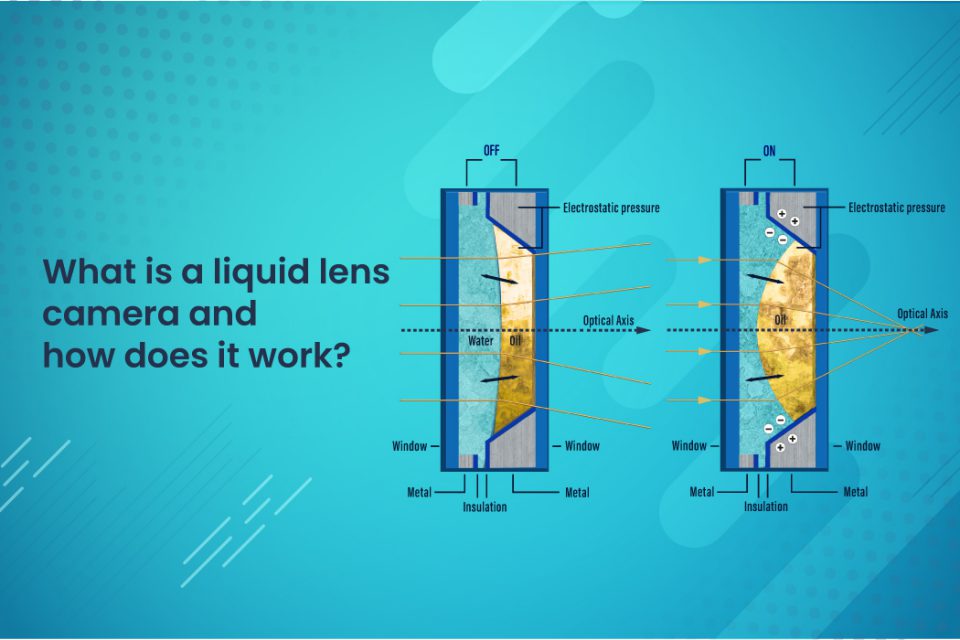Liquid lenses are a relatively new technology that is fast gaining traction in the world of embedded vision. They provide several advantages over standard lenses in a wide range of applications where an autofocus camera is required. In addition, their adaptability and versatility have been key factors in their widespread acceptance. This blog will explore what liquid lens technology is and how it works.
So, let’s get into it.
What is a liquid lens?
A liquid lens is a camera technology that substitutes a static optical glass lens. It uses optical-grade liquid in the center of a cell structure and functions similarly to an eye lens. A liquid lens permits the lens to change the form by means of adjusting the liquid inside it, which improves focusing speed and focal length.
How does a liquid lens camera work?
Consider a single water droplet on a leaf, as seen in photography publications. The fluid in a liquid lens directs light onto an image sensor in the same way as this bead refracts natural light. Mechanical components are rarely used in liquid lenses. Instead, a clear fluid capsule is contained within them. This pod’s form may be changed by putting pressure on a portion of it. The trajectory of light traveling through the optical-grade fluid and the focal length are changed by squashing or stretching it.
In a liquid lens camera, the lens uses various methods to exert pressure on the capsule being used. One such is known as ‘electrowetting’ – involving the process of combining water with a separate layer of non-conductive oil in the lens. In addition, the curvature and the refractive effect may be changed by putting voltage across the border in a fraction of a second.
Differences between liquid lens and traditional lens
The primary distinction is that traditional camera systems use optical lenses composed of glass and have a set curvature radius. On the other hand, liquid lenses are tiny cells that hold an optical-grade liquid (a combination of water and oil) that may change the form, resulting in variable curvature and focal lengths.
Another difference is that liquid lenses are substantially faster than optical lenses at determining depth-of-field and focusing on objects. As a result, they can successfully lock the focus even while the subject is moving, but optical lenses struggle to restore focus.
How does liquid lens autofocus differ from VCM autofocus?
Autofocus in cameras is achieved using predominantly two types of lenses – a liquid lens and a VCM (Voice Coil Motor) autofocus lens. There are no mechanical pieces inside liquid lenses, making them unique. At the same time, a VCM autofocus camera relies on the mechanical movement of the lens to change focus. This leads to challenges like wear and tear (which implies reduced lifetime), increased heat dissipation, more power consumption, increased time to focus, etc. A liquid lens wins the game when it comes to all these parameters. For instance, e-con Systems’ 3.4 MP autofocus camera See3CAM_30 – based on onsemi AR0330 – comes with a liquid lens that delivers superior autofocus performance.
Now let us look at a couple of disadvantages of liquid lenses in comparison with VCM autofocus lenses. Liquid lens is far costlier compared to VCM lenses. Also, the supply chain of VCM autofocus lenses is much wider, and hence offers better availability and supplier variety.
Interested in knowing more about autofocusing in liquid lenses and VCM? Please read our blog Liquid lens Autofocus vs. Voice Coil Motor (VCM) Autofocus.
Advantages & disadvantages of liquid lens
In the previous section, we looked at the differences between a liquid lens and a VCM autofocus lens. In this section, let us have a comprehensive look at the advantages and disadvantages of liquid lenses.
Liquid lenses provide several benefits over regular optical lenses, such as:
- It’s fairly compact when compared to traditional lenses used in embedded camera solutions.
- It’s also faster, has more focal lengths, and uses a lot less power than a motorized camera.
- A huge camera module with several lenses isn’t required – one liquid lens can handle all the focal lengths.
- It provides good image stabilization.
However, liquid lens technology has a few disadvantages, as well, namely:
- Experts opine that light scattering may cause issues.
- Preventing fluids from flowing in tight areas can prove to be challenging.
- Liquid lenses tend to be costlier than other lenses even in volumes of several tens of thousands.
Major applications of liquid lens autofocus in embedded vision
Liquid lens cameras are autofocus cameras that are used typically in applications that require the camera to focus on objects at varying distances. They can function with both small and big sensor formats, as well as visible and near-infrared light, making them adaptable across a variety of embedded vision applications. While the list of applications could be endless, let us look at some of the most popular of them here:
- E-commerce and industrial applications
- Life Sciences
- Biometrics
E-commerce
Liquid lens technology is helping to improve e-commerce logistics. Fixed-mount and portable barcode readers both employ liquid lenses. The scanning of barcodes for package tracking occurs several times during shipping. Liquid lenses are used to scan things using handheld scanners during pickup, fixed scanners at logistics hubs, and handheld scanners again at delivery. Liquid lens cameras used in such industrial environments make package tracking quick, precise, and dependable.
Life Sciences
Liquid lenses are known to power microscopy applications due to their seamless autofocus capability. It makes sure that multiple object planes are covered. Also, they can be integrated into miniature cameras, which is very useful for microscopic devices.
Biometrics
The explosive uptick in digital transformation has driven the urgent need for heightened security systems. Liquid lens-enabled solutions are more efficient than traditional optical solutions in establishing more future-ready security protocols like iris recognition. They offer the accuracy and speed required, along with the autofocus power, to enable the smooth functioning of these contactless identification and verification systems.
Other popular use cases of embedded vision leveraging liquid lenses include smart farming, UAV, dentistry, document scanners, wound measurement devices, etc.
Liquid lenses are certainly the imaging technology of the future. As cameras have become a more common part of our lives, the drive for advancements in the technology has resulted in smaller cameras with ever-increasing capabilities.
Liquid lens cameras offered by e-con Systems
e-con Systems has been pushing the envelope in the embedded vision world for close to two decades. We take pride in front of the innovation curve by creating future-ready camera solutions. Please take a look at some of our liquid lens cameras:
- See3CAM_160 – 16MP autofocus USB 3.1 Gen 1 camera
- e-CAM160A_MI298_MOD – 16MP autofocus camera module
- See3CAM_130 – 4K autofocus USB camera
- e-CAM130_MI1335_MOD – 13MP autofocus camera module
- See3CAM_30 – 3.4 MP autofocus USB camera with liquid lens
If you are looking for help in integrating cameras into your products, please write to us at camerasolutions@e-consystems.com. You could also visit our Camera Selector to get a complete view of our camera portfolio.

Prabu is the Chief Technology Officer and Head of Camera Products at e-con Systems, and comes with a rich experience of more than 15 years in the embedded vision space. He brings to the table a deep knowledge in USB cameras, embedded vision cameras, vision algorithms and FPGAs. He has built 50+ camera solutions spanning various domains such as medical, industrial, agriculture, retail, biometrics, and more. He also comes with expertise in device driver development and BSP development. Currently, Prabu’s focus is to build smart camera solutions that power new age AI based applications.




